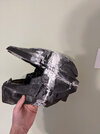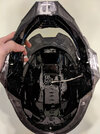Sorry for the MASSIVE pause in between uploads, I took a bit of a break in order to catch up on some school and mental stuff
Anyways! Seeing how it's been quite some time I have some
exciting updates considering my armor cosplay, this one's a doozey.
I finally completed the main torso pieces, the seams aren't quite ideal but when I'm movin and shmovin and groovin... nobody can really notice
that much... I hope...
Firstly I filled the inside with resin to keep it from breaking so easily, yadda yadda y'all have already seen me talk about this here.
How I decided to wear it was a brainstorm and a half let me tell you that.
The tops of the two halves are connected by adjustable straps that can technically "unbuckle", but aren't meant to all too much. The lower of the pieces snap in place with straps on magnets. This setup makes it super easy to pull over my head and lock it in place (see pictures below). It also allows me to put it on by myself and takes less than a minute.
I spaced the inside out with strategically placed foam, most notably: I put a 'bar' of foam across where my ribs meet the squishy part of my stomach, as to have the lowest possible contact whilst still maintaining proper flexibility (not that I'm flexible to begin with). Two lengths of foam in a triangle-ish pattern down the back so it doesn't press uncomfortably on my spine but still allows for hold while moving.
Then there's just some foam bars to keep the plastic from digging into my shoulders.
I placed denser EVA foam in places the plastic rubbed on each other to help decrease chipping and scraping of the paint. Mainly around the top hinges and where the bottom arms come in contact.
Finally I designed a little thingy out of EVA foam and stuck in in the neck to help fill some of the space between the torso and helmet. (Not in pictures I'm wearing it).
Tip 1: Round the foam a bit by cutting it a certain way, this makes it wayyy more comfortable to wear.
Tip 2: Coat the inside in resin if you're tired of stuff breaking easily.
Tip 3: Strap-hinges and magnets are
SO much nicer than buckles.
Yes I know I have a smudge on my mirror
deal with it.
Also here's a video of my struggling for a solid minute, enjoy.



